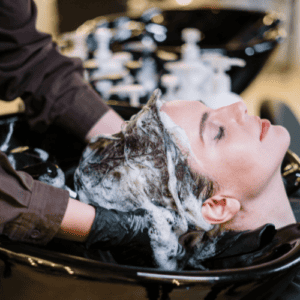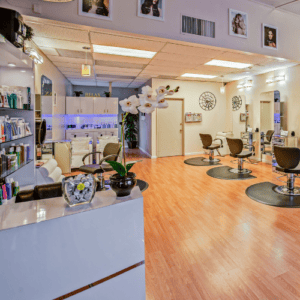Hair Salon Business Plan Template
If you want to start a hair salon business or expand your current one, you need a business plan.
Over the past 20+ years, we have helped over 5,000 entrepreneurs and business owners create business plans to start and grow their hair salons.
How to Write a Business Plan for a Salon
Below are links to each section of your hair salon business plan template:
2. Company Overview
3. Industry Analysis
4. Customer Analysis
5. Competitive Analysis
6. Marketing Plan
7. Operations Plan
8. Management Team
9. Financial Plan
10. Appendix
Hair Salon Business Plan FAQs
What Is the Easiest Way to Complete My Hair Salon Business Plan?
Growthink's Ultimate Salon Business Plan Template allows you to quickly and easily complete your salon business plan.
Where Can I Download a Hair Salon Business Plan PDF?
You can download our beauty salon business plan sample pdf here. This is a sample business plan for salon owners that you can use in PDF format.
What Is a Hair Salon Business Plan?
A business plan provides a snapshot of your salon as it stands today, and lays out your growth plan for the next five years. It explains your business’ goals and your strategy for reaching them. It also includes market research to support your plans. Your business plan is the roadmap to your salon’s success and growth.
Why Do You Need a Business Plan?
If you’re looking to start a salon or grow your existing salon you need a business plan. A business plan will help you raise funding, if needed, and plan out the salon’s growth in order to improve your chances of success. Your business plan is a living document that should be updated annually as your company grows and changes.
What Are the Sources of Funding for a Hair Salon?
 With regards to funding, the main sources of funding for a salon are bank loans and angel investors. With regards to bank loans, lending institutions will want to review your salon business plan and gain confidence that you will be able to repay your business loan payments including interest. To acquire this confidence, the loan officer will not only want to confirm that your financials are reasonable. But they will want to see a professional business plan. Such a plan will give them the confidence that you can successfully and professionally operate a salon business.
With regards to funding, the main sources of funding for a salon are bank loans and angel investors. With regards to bank loans, lending institutions will want to review your salon business plan and gain confidence that you will be able to repay your business loan payments including interest. To acquire this confidence, the loan officer will not only want to confirm that your financials are reasonable. But they will want to see a professional business plan. Such a plan will give them the confidence that you can successfully and professionally operate a salon business.
The second most common form of funding for a salon is angel investors. Angel investors are wealthy individuals who will write you a check. They will either take equity in return for their funding or, like a bank, they will give you a loan. Venture capitalists will not fund a salon. They might consider funding a chain of hair salons, but never an individual location. This is because most venture capitalists are looking for millions of dollars in return when they make an investment, and an individual location could never achieve such results.
What are the Components of a Hair Salon Business Plan?
 There are ten key components to any salon business plan includes:
There are ten key components to any salon business plan includes:
- Executive Summary - This is the key section of your salon business plan. It’s typically one or two pages long, but accomplishes three goals: it introduces you to the reader, explains why your salon will succeed and shows how you’ll accomplish this goal.
- Company Description - As the salon owner, you’ll need to describe your company in one to two pages max. This section should tell the reader what makes your company unique, different, and worth investing time into.
- Market Analysis - A market analysis is a key component of every salon business plan because it gives you an idea of industry trends, who your customer is and where you can find them. Your market analysis should include your customer’s spending habits, what they value in a salon, and why you are different. There is no need to conduct consumer research; rather it can be done using publicly available data.
- Customer Analysis - This section should be dedicated to your prospective customers, including their market demographics and psychographics. Depending on the location of your new salon, your target audience may include working professionals, middle-class families, etc.
- Competitive Analysis - Your competitive analysis shows how you plan to take over the market. It should include a full description of your direct and indirect local competition including other salons and other options for individuals to receive a haircut. You will break down their strengths and weaknesses, customer perceptions of them, and determine the competitive advantage of your own salon to better attract and retain customers.
- Marketing Plan - Marketing is what gets your customers into the door at your salon. It’s how you will get noticed amidst all of your competition. You should include a marketing plan detailing how you plan to cultivate brand awareness, which channels you intend to use, who will be responsible for executing this salon marketing strategy, and how it ties in with your company’s mission statement.
- Operations Plan - Detail every aspect of running your salon business. Who will be responsible for what duties? How will you manage inventory? What systems need to be put in place in order to ensure that your customers receive a positive experience when they come into the salon and that they return after their visit?
- Management Plan - Your company needs to be run by a management team that knows what they are doing and cares about your salon. This section of the salon business plan should cover their experience, qualifications for running a salon, how they will work together as a team, etc.
- Financial Plan - A detailed financial plan includes details about service sales and marketing budgets, startup costs including salon equipment, projections, and three-year forecasts. Be sure to include the following financial statements: income statement, balance sheet, and cash flow statement.
- Appendix - Finally, your business plan needs to include an appendix. This is where you put any supporting documents that back up your claims and projections stated in the financial plan. For example, if you claim that 3 percent of all Americans get their hair cut every two months, this will be backed up by a public data source.
We offer more details and prompting questions in the article above to help you write a business plan for your own salon.
Is My Hair Salon in a Good Business Location?
When looking at a neighborhood in which to open a salon, you should look for a local market where there is a high population density. You want people who are walking by the front of your store every day, and this will create an easy flow of foot traffic.
Be sure to also research the competitor salons in the local community. Identify how you can stand out from the competition to gain more market share to grow your business.
How Much Does It Cost To Open a Hair Salon?
 The cost to open a salon can vary. Capitalization costs usually average between $50,000 and $150,000. These are one-time fees for rent on the space you have leased, equipment needed to run your salon business, furniture for the salon, insurance premiums, attorney fees for lease negotiations and legal documents needed to open your doors, and hiring a contractor to build out the space.
The cost to open a salon can vary. Capitalization costs usually average between $50,000 and $150,000. These are one-time fees for rent on the space you have leased, equipment needed to run your salon business, furniture for the salon, insurance premiums, attorney fees for lease negotiations and legal documents needed to open your doors, and hiring a contractor to build out the space.
How to Start a Salon Business
Starting a salon can be very exciting, but it's likely that you are using personal funds to get you off the ground. Here are some other steps to take when starting a hair salon business:
- Write a business plan to help you identify risks, project expenses, and sales forecasts, and determine if your hair salon will be profitable in your target market.
- Decide if you will lease or buy a space for your hair salon. Scout out available options in your desired area and reach out to a real estate or property management agent to make arrangements to secure your location.
- Assess how much it will cost to make necessary changes and/or additions to your salon location. This can include construction, furniture, utilities, permits, fixtures, and salon equipment installation.
- Determine how much additional funding you will require for startup expenses including licenses, permits, marketing, inventory, equipment, salon products, and brands, etc. Seek additional funding through business loans and/or angel investors as needed.
- Once funding is secured, begin developing the space for your salon, determine the inventory you have to work with, and purchase any additional supplies and products that you need to prepare for opening.
- Hire the right people, including salon stylists, front desk staff, and assistants as needed to maintain positive cash flow from day one. Consider hiring a general manager to oversee the day-to-day operations of your salon. This will free up time for you to focus on marketing efforts, product purchases, hiring staff members, and other important tasks as they arise.
- Keep up to date with local and state regulations surrounding hairdressers, salon managers, and cosmetologists. This will help you determine the licenses, permits and insurance your hairdressing business needs to operate successfully.
- Review tips from salon entrepreneurs who have been in your shoes before, that can help you avoid common pitfalls as well as increase success rates for new small businesses.
- Open your doors for business! Make sure you have a steady flow of clients after opening by promoting your hairdresser business through local directories, free classifieds sites like Craigslist, or other business marketing strategies.
Read More: How to Start a Hair Salon Business
What are Some Specific Salon Business Tips?

While every salon owner has their own unique ways of running their company, there are many similarities that you will want to cover in your business plan.
- While every salon is different, they all provide some level of customer service. Make sure you understand how your business compares to other salons and what you plan to do better.
- Make sure that the packages for each of your beauty services are clearly stated and easy to understand. It should be very clear what your salon offers and what’s included in the listed price.
- Allocate a percentage of your salon expenses budget to marketing in order to attract new customers. While you may have existing clients, if you want to grow, you’ll need more.
- Keep your salon clean and modern. How you care for your salon is a reflection of how you will care for your clients’ beauty needs.
- Highlight the designer names of all products that you currently use in order to display quality beauty services.

 Use This Simple Business Plan Template
Use This Simple Business Plan Template How to Create a Great Business Plan
How to Create a Great Business Plan The Perfect Outline for a Business Plan
The Perfect Outline for a Business Plan How to Expertly Format a Business Plan
How to Expertly Format a Business Plan 100 Sample Business Plans
100 Sample Business Plans Business Plan Consulting Services
Business Plan Consulting Services Salon Business Plan Template
Salon Business Plan Template Nail Salon Business Plan Template
Nail Salon Business Plan Template Beauty Salon Business Plan Template
Beauty Salon Business Plan Template